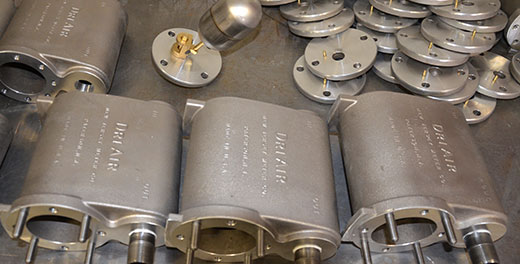Get This Report on Aluminum Castings Company
Table of ContentsAluminum Castings Company Can Be Fun For AnyoneNot known Incorrect Statements About Aluminum Castings Company Fascination About Aluminum Castings CompanySome Known Facts About Aluminum Castings Company.9 Easy Facts About Aluminum Castings Company DescribedAluminum Castings Company Can Be Fun For EveryoneSome Ideas on Aluminum Castings Company You Should KnowAluminum Castings Company Things To Know Before You Buy
There are 2 primary kinds of die spreading used in the light weight aluminum casting market: warm chamber pass away spreading and cold chamber die spreading. The key difference between these methods is exactly how the molten steel is delivered to the mold and mildew. In hot chamber die casting, frequently used for lower melting point metals, the melting pot is straight linked to the equipment, and a plunger requires the product through a gooseneck into the die tooth cavity.
What Does Aluminum Castings Company Do?
In these techniques, the mold and mildew is deliberately destroyed or damaged away in order to extract the ended up aluminum spreading. Typical procedures under the group of expendable mold and mildew spreading include (financial investment casting),,, and financial investment spreading. When manufacturing custom aluminum parts making use of expendable molds, producers put molten aluminum or aluminum alloys into the mold and mildew, which is after that busted apart to launch the strengthened steel component.
The is among the earliest and most favored kinds of aluminum spreading. It involves condensing specialized factory sand, usually strengthened with clay or material, around a specifically crafted recyclable pattern that identifies the form and internal information of the ended up aluminum item. The pattern system includes risers and vents to take care of the circulation of molten steel and to stop casting problems such as shrinking porosity.
The 25-Second Trick For Aluminum Castings Company

This mold is after that preheated prior to the pouring of liquified light weight aluminum or light weight aluminum alloy. As the steel fills the covering, it records the complex details and fine surface finish of the mold and mildew. Once cooled, the ceramic is mechanically or chemically broken away, enabling the elimination and splitting up of individual cast parts.
The 9-Second Trick For Aluminum Castings Company
Irreversible mold and mildew casting makes use of recyclable metal mold and mildews and is excellent for automation with constant quality and much less waste. Expendable mold and mildew casting makes use of single-use molds, like sand or foam, using design versatility and lower tooling expenses for prototypes or brief runs. Die spreading is best for producing high volumes of light weight aluminum parts that call for tight resistances, great details, and smooth surface areas.
The Toshiba Maker DC-J Collection includes pass away casting machines appropriate for light weight aluminum. Known for their durable construction and high injection efficiency, these equipments guarantee efficient and precise spreading (Sand Foundry).

While aluminum can be used in its pure form, it is commonly alloyed with various other metals to improve its residential properties or the buildings of the other steels. These alloys use enhanced performance for various applications. Light weight aluminum alloys are classified into eight collection, phoned number from one to 8. The very first digit(s) of the number indicate the key alloying component incorporated with light weight aluminum.
Little Known Questions About Aluminum Castings Company.
This alloying enhances the toughness and solidity of aluminum but reduces its ductility and deterioration resistance. The 3000 series alloys are largely alloyed with manganese.
The 4000 collection alloys are alloyed with silicon, which decreases the melting factor and boosts fluidness. This makes it a preferred choice for spreading, as it is very easy to form in its molten state.
Not known Details About Aluminum Castings Company
This series is classified as a high-strength alloy, particularly matched for sheet and plate applications as a result of its superb weldability. Its resistance to rust from acids and alkalis makes it perfect for use in rough and aggressive environments (Metal Foundry). The 6000 collection alloys are alloyed with both magnesium and silicon, giving a balance of strength, mechanical homes, and rust resistance
Handling the 6000 collection needs specialized and innovative tools, which can be complicated and costly. This collection is known for its exceptional corrosion and oxidation resistance, as well as its simplicity of covering, therapy, and workability. The 7000 collection aluminum alloys are the greatest and most sturdy amongst light weight aluminum types, with stamina equivalent to around two-thirds of industrial-grade A3 steel.
3 Simple Techniques For Aluminum Castings Company
Zinc is the primary alloying element in the 7000 collection, improving the firmness of the light weight aluminum, also though zinc's firmness Recommended Site resembles that of aluminum on the Mohs scale. The 8000 collection light weight aluminum alloys are mostly alloyed with tin, in addition to percentages of copper and nickel (Aluminum Melting and Casting). While these alloys offer lower strength contrasted to various other series, they stand out in machinability and wear resistance
Light weight aluminum cast heatsinks are electrically conductive, permitting them to be grounded successfully. They are typically cast with incorporated functions that reduce the demand for additional procedures, such as extra machining or assembly, bring about additional cost financial savings. Aluminum spreading is often used to make brackets for both sturdy commercial equipment and family home appliances.
The Greatest Guide To Aluminum Castings Company
The single-piece construction of aluminum brackets boosts their strength and sturdiness, reducing the probability of failure. If openings are needed, they can be consisted of directly in the casting mold and mildew, decreasing the requirement for post-production ending up (https://swaay.com/u/kelliphillips61401/about/). Producers have increasingly taken on light weight aluminum casting for golf tools because of its toughness, stability, and flexibility in shaping